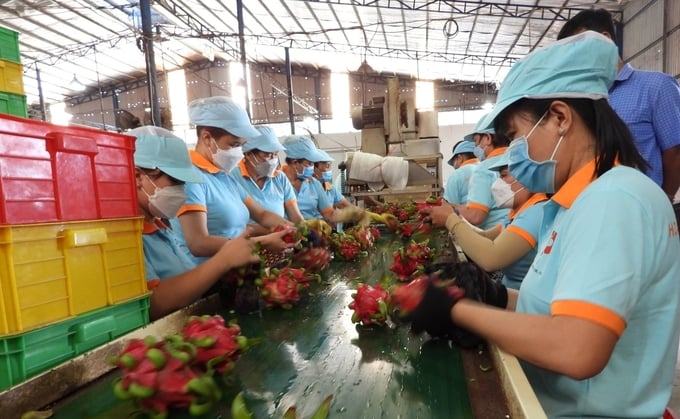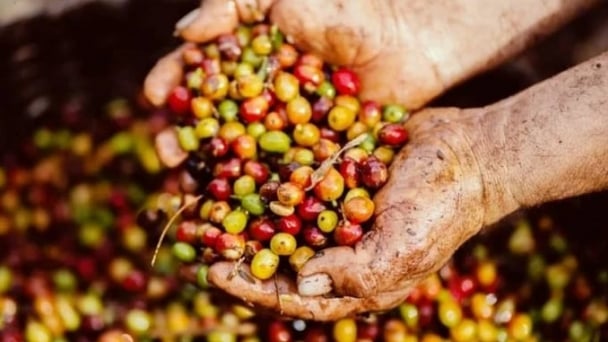June 18, 2025 | 03:28 GMT +7
June 18, 2025 | 03:28 GMT +7
Hotline: 0913.378.918
June 18, 2025 | 03:28 GMT +7
Hotline: 0913.378.918
The peak period of dragon fruit production in both area and output has passed, and now Vietnam will have to compete very fiercely with other countries. India is growing 50,000 ha of dragon fruit. South American countries have also increased the dragon fruit growing area. China - the largest export market of Vietnamese dragon fruit, has also planted dragon fruit with an area of 67,000 ha and it may increase in the near future.
The export value of Vietnamese dragon fruit was only USD 57.15 million in 2010, then in 2017 it was USD 1.1 billion and in 2018 it was approximately USD 1.3 billion, reaching the peak export year. However, since 2022 dragon fruit export turnover has stagnated. As of August 2023, Vietnam's dragon fruit export turnover is just over USD 400 million.

Vietnamese dragon fruit meets increasingly fierce competition from dragon fruits from other countries in the world market. Photo: Nguyen Thuy.
Tran Dai Nghia, Head of the Department of Economics - Environmental Resources (Institute of Policy and Strategy for Agricultural and Rural Development) states the basic bottlenecks of Vietnamese dragon fruit. The quality is unstable, and the industry mainly export fresh products (over 90%). The growing area meeting GAP, GlobalGAP, or organic standards remains low. Technology to preserve fresh dragon fruit for long-distance transport is limited, not to mention the lack of irradiation and vapor compression facilities which can meet the requirements of the USA and Hong Kong markets.
“The technology we use to process dragon fruit is still simple. We have weak linkage in the value chain, small scale production and undeveloped horizontal linkage. There is not much production model that underwrites products for farmers or other subjects such as cooperative and businesses, and it is mostly done through traders. Enterprises have not put much effort in expanding the market and pushing consumption, especially the domestic market, while export still heavily depends on the Chinese market,” says the Head of the Department of Economics - Environmental Resources.
Tien Giang currently has over 10,000 ha of white, red, and yellow flesh dragon fruits, mostly white flesh dragon fruits. According to Pham Van Trong, Vice Chairman of Tien Giang People's Committee, the Mekong Delta in general and Tien Giang in particular are provinces vulnerable to climate change, so there needs to be solutions to increase resilience and adaptability for dragon fruit orchards.

Dragon fruit production and trading cooperatives in Binh Thuan province introduce dragon fruit products to leaders of the Ministry of Agriculture and Rural Development and international organizations. Photo: Nguyen Thuy.
In the case of Binh Thuan, despite being one of the largest dragon fruit production provinces, this province also faces many difficulties due to many objective and subjective reasons. By the end of 2020, Binh Thuan had 33,000 ha of dragon fruit, but due to Covid-19, the province struggled to export at the northern border gates. This greatly affected the production situation of local growers. Since 2022, the area of dragon fruit in the province has decreased to 27,000 ha.
Tran Thanh Binh, Head of the Department of Import - Export of Agricultural, Forestry and Fishery Products (Ministry of Industry and Trade), says that Vietnam’s annual dragon fruit output is 1.2 - 1.4 million tons, with 85% for export and 15% for domestic consumption (200,000 - 300,000 tons) through supermarkets, markets and processing factories.

Deputy Minister of Agriculture and Rural Development Tran Thanh Nam (third from left) visits a booth introducing processed dragon fruit products at the Conference "Sustainable Dragon Fruit Development in Vietnam" held on September 29 in Ho Chi Minh City. Photo: Nguyen Thuy.
Since there is no sign of strong consumption of dragon fruit in the domestic market compared to other fruit commodities, Binh believes there remains big potential for dragon fruit in the 100-million-people market.
From the viewpoint of Nguyen Thai Binh, Chairman of the Vietnam Fruit and Vegetables Association, Vietnamese dragon fruit faces fierce competition from the importing country China itself. This is an unequal battle between Vietnamese dragon fruit and Chinese dragon fruit right in the Chinese market. Manufacturers have lost confidence and direction, so Vietnam's dragon fruit growing area decreased rapidly. Farmers are replacing dragon fruit with other products such as durian.
"Having to compete with products from the importing country, we need to improve the competitiveness of Vietnamese dragon fruit by improving product quality and taking advantage of the time when China does not produce dragon fruit.
“Enterprises should find new markets for dragon fruit and at the same time diversify dragon fruit products for major markets such as the USA and Europe. The State must call for more investment in infrastructure especially in concentrated production areas to support agricultural production in general and fruit production in particular, which includes dragon fruit,” said Chairman Nguyen Thai Binh.
Translated by Samuel Pham
![Turning wind and rain into action: [7] Early disaster warnings help marine farmers minimize losses](https://t.ex-cdn.com/nongnghiepmoitruong.vn/608w/files/news/2025/06/17/z6704423696987_15fd32ffc26d590d204d520c9dac6786-nongnghiep-142942.jpg)
(VAN) In recent years, thanks to early disaster warnings and forecasting, marine farmers in Khanh Hoa province have been able to reduce risks and losses, thereby improving production efficiency.
![Turning wind and rain into action: [6] ‘Four on-the-spot’ disaster management software](https://t.ex-cdn.com/nongnghiepmoitruong.vn/608w/files/news/2025/06/17/e5a48259d6a262fc3bb3-nongnghiep-183800.jpg)
(VAN) By simply activating the scenario on the disaster management software, the relevant authorities immediately know how many households need to be evacuated, where to evacuate them to, and by what means of transportation…
![Turning wind and rain into action: [5] Hue applies modern technology in disaster forecasting](https://t.ex-cdn.com/nongnghiepmoitruong.vn/608w/files/news/2025/06/17/z6704423696987_15fd32ffc26d590d204d520c9dac6786-nongnghiep-093938.jpg)
(VAN) In Hue city, modern technology has recently been applied in meteorological and hydrological forecasting and warning, helping to reduce the damage caused by natural disasters.

(VAN) A cutting-edge farming technique being implemented on an experimental ranch in Arizona's Sonoran Desert has already saved a billion gallons of water over five years, according to Civil Eats.

(VAN) Poultry and pig production and the environment can be boosted through enhanced water technology, according to new research.

(VAN) Coffee prices on June 16, 2025 are unchanged. In Vietnam, local trading prices are holding steady, ranging around VND 112,000 – VND 112,500/kg.
![Turning wind and rain into action: [4] Bringing climate bulletins to remote and isolated areas](https://t.ex-cdn.com/nongnghiepmoitruong.vn/608w/files/linhnhp/2025/06/14/1152-z6704423696987_15fd32ffc26d590d204d520c9dac6786-nongnghiep-151141.jpg)
(VAN) The Vietnam Agriculture and Nature Newspaper interviewed Mr. Vu Thai Truong, Acting Head of Climate Change and Environment at UNDP Vietnam, to gain deeper insight into how climate bulletins are delivered to farmers.